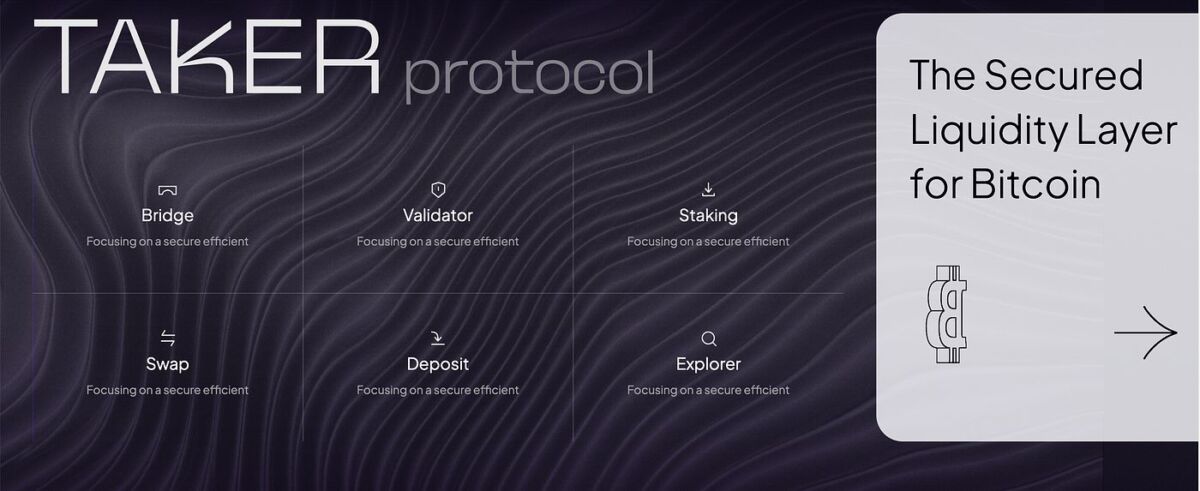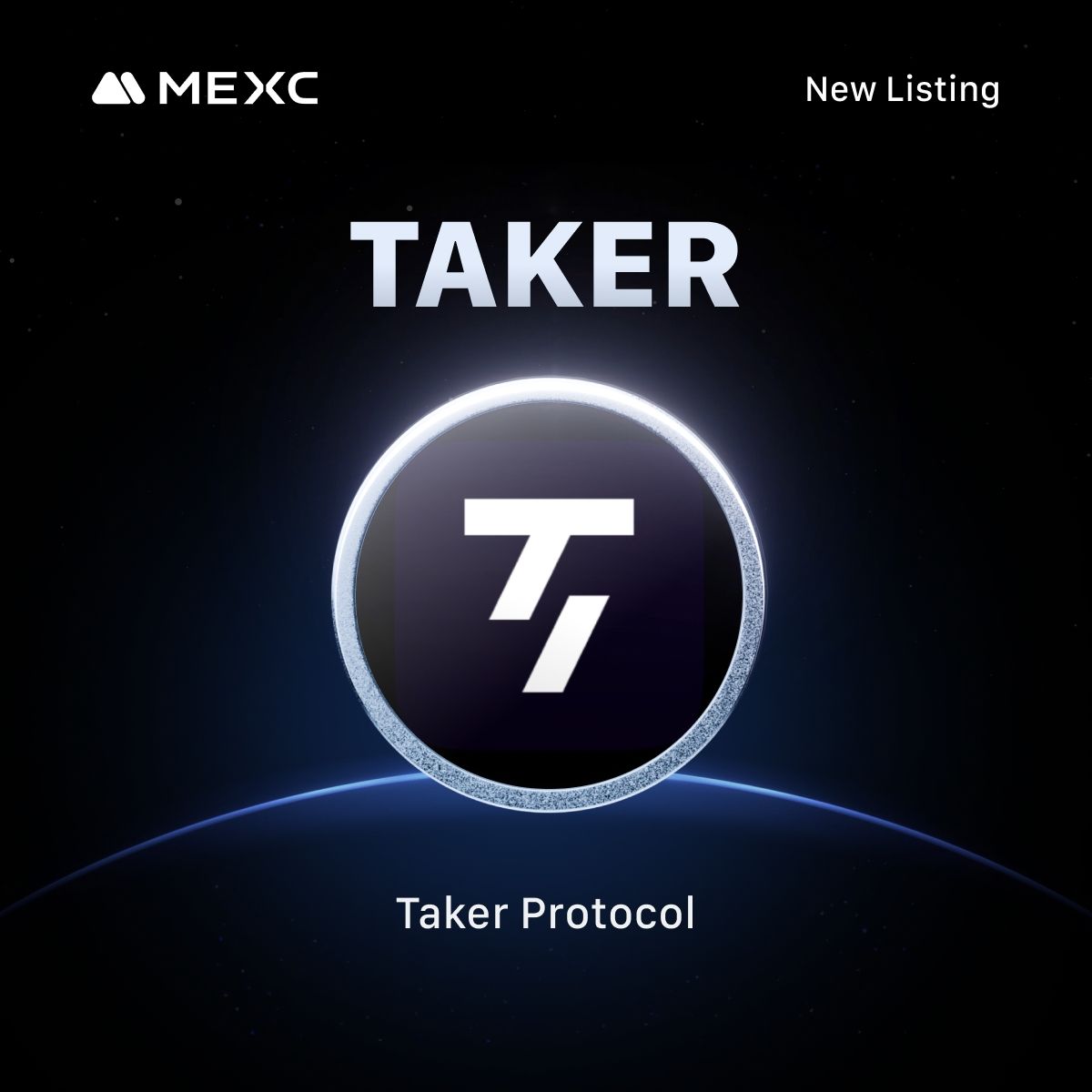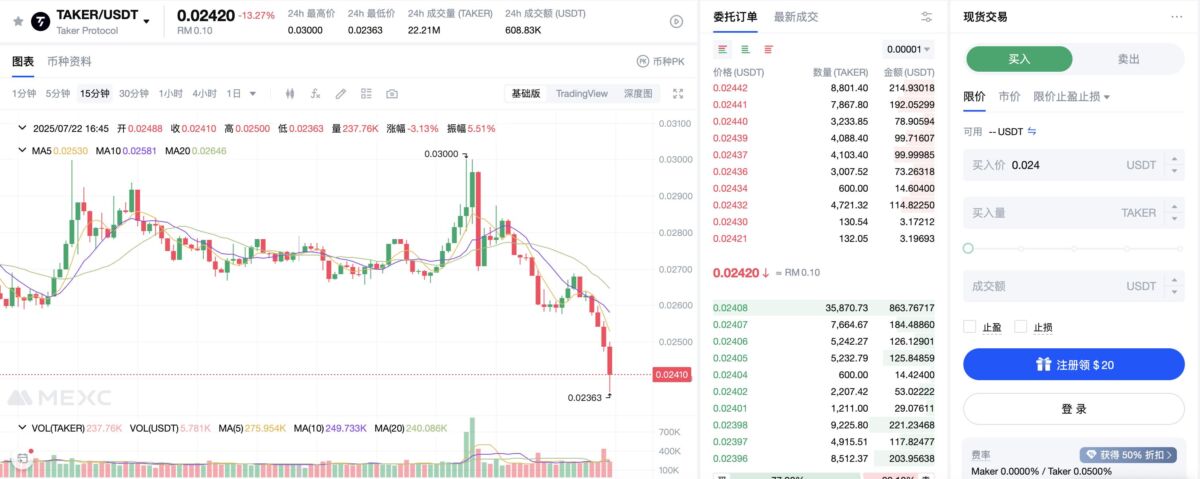Preface
Taker Protocol is a cross-chain liquidity underlying protocol specifically designed for the Bitcoin ecosystem. Its innovative consensus mechanism NPOL (Nominated Proof-of-Liquidity) binds liquidity providers to network security mechanisms, allowing BTC and BRC-20 assets to be staked securely while generating yields. Users can become validators or nominators by staking LP tokens, earning transaction fees and block rewards, and participating in governance.
Based on Taker Chain the Taker protocol supports EVM compatibility and DHC cross-chain bridge technology, enhancing the usability of Bitcoin across multiple scenarios such as DeFi, lending, NFTs, and gaming. At the same time, the protocol has a total issuance of 1 billion $TAKER tokens, which are used for ecosystem incentives, staking rewards, and governance participation. Taker Protocol is building a secure, scalable, and decentralized Bitcoin DeFi infrastructure layer aimed at activating dormant Bitcoin liquidity and supporting sustainable ecosystem growth.

Key Takeaways
- Taker Protocol through its innovative Nominated Proof-of-Liquidity (NPOL) consensus mechanism directly integrates the liquidity of Bitcoin and BRC-20 assets into network security mechanisms, creating an incentivized DeFi infrastructure layer;
- Users can stake LP tokens such as BTC/Ordi and BTC/Sats to become validators or nominators, earning transaction fees and block rewards, while participating in network governance and ecosystem incentives;
- Taker Chain supports EVM compatibility, and achieves secure cross-chain bridging through Dynamic Hidden Committee (DHC) technology, expanding the usability of Bitcoin in DeFi, trading, lending, and gaming scenarios;
- $TAKER has a total issuance of 1 billion tokens, used for rewards, governance, ecosystem development, and staking returns, to build a fair and sustainable economic model.
1. Overview and Vision of the Taker Protocol Project

1.1 Challenges of Bitcoin Liquidity
DespiteBitcoinbeing the largest cryptocurrency by market cap, its usability has long been limited to value storage and basic transactions, rendering its practicality limited. The vast majority of Bitcoin holdings remain idle, constituting a huge untapped liquidity pool that could support a thriving DeFi ecosystem. Traditional proof-of-stake mechanisms, while effective for other blockchains, are not adequately adaptable to Bitcoin’s unique attributes and the specific needs of its holders.
Taker ProtocolIt is recognized that many Bitcoin and BRC-20 tokenholders (such as Ordi, Sats) face liquidity shortages when trading on-chain, and the use cases for assets are quite limited. Especially for Bitcoin whales, it is difficult to achieve stable gains from their held assets while ensuring security and decentralization.
1.2 Core Mission and Value Proposition of Taker Protocol
The mission of Taker Protocol is to enhance the yield scale of Bitcoin through its original NPOL consensus mechanism, which binds liquidity provision incentives to ecological growth through a symbiotic yield model. The protocol aims to unleash the enormous potential of the Bitcoin ecosystem in the following ways:
Activating dormant Bitcoin liquidity: transforming idle Bitcoin into effective assets that generate yields while ensuring security.
Supporting diverse application scenarios: providing ample liquidity for layer two solutions, native swaps, re-staking protocols, lending platforms, and gaming applications.
Building a sustainable incentive system: establishing a reward mechanism that encourages long-term participation and ecological development.
Achieving cross-chain functionality: facilitating seamless interaction between Bitcoin and other blockchain ecosystems.
1.3 Technical Architecture
Taker Protocol operates as a dedicated blockchain (Taker Chain), specifically designed to optimize the utilization of Bitcoin assets. Its architecture integrates several key innovations:
Cross-chain bridging technology: the protocol employs advanced decentralized hash chain (DHC) technology to achieve secure bridging of BTC and BRC-20 tokens from the Bitcoin network to Taker Chain. This ensures users can safely transfer assets while maintaining cryptographic security.
Ethereum Virtual Machine (EVM)Compatibility: The Taker chain supports the Ethereum Virtual Machine, allowing developers to utilize familiar development tools and frameworks to deploy existing decentralized finance protocols and create new applications.
Modular Liquidity Framework: The protocol achieves liquidity abstraction through native security, providing developers with flexible building blocks to help them develop exchange, lending protocols, stablecoin projects, and other decentralized finance applications without bearing additional infrastructure costs.
2. Technical Innovations of Taker Protocol: Nomination Liquidity Proof (NPOL) Consensus Mechanism
2.1 NPOL Mechanism Analysis
The Nomination Liquidity Proof consensus mechanism is the most significant technological innovation of the Taker Protocol. Unlike traditional Proof of Work (PoW) or Proof of Stake (PoS) mechanisms, NPOL directly links network security with liquidity provision, forming a self-reinforcing cycle that benefits individual participants as well as the entire ecosystem.
In the NPOL system, users can stake liquidity provider (LP) tokens representing various Bitcoin trading pairs, including:
BTC/Ordi, BTC/Sats, BTC/WBTC, BTC/BTCB, BTC/USDT, BTC/USDC, BTC/ETH
By staking these LP tokens, participants can become validators or nominators in the network while earning trading fees generated from liquidity provision and block rewards from network participation.
2.2 Technical Advantages of NPOL
Enhanced Security Model: NPOL avoids the common diminishing returns of network security seen in traditional PoS networks. As more liquidity is injected into the system, both security and functionality increase proportionally, creating a positive feedback loop.
Maintaining Decentralization: Unlike the centralized tendency in PoS systems where rewards concentrate toward large token holders, NPOL allocates rewards based on staking size and actual liquidity contributions, fostering more equitable participation.
Energy Efficiency: While maintaining robust security guarantees, NPOL’s energy consumption is far lower than that of Bitcoin’s PoW consensus mechanism, achieving environmental sustainability while adhering to decentralization principles.
Functional Liquidity: Unlike traditional staking where assets are locked and unusable, NPOL ensures that the liquidity staked remains functional and can be efficiently utilized by applications within the Bitcoin ecosystem.
2.3 Consensus Process
Asset Bridging: Users bridge BTC and BRC-20 tokens to the Taker chain using DHC technology.
Providing Liquidity: Assets are paired and injected into various trading pools to provide liquidity.
LP Token Staking: Users stake LP tokens and lock them to earn veTAKER rewards.
Validator/Nominator Selection: Participants become validators or nominators by staking veTAKER.
Block Generation: The network generates blocks through the NPOL consensus mechanism (including validator rotation).
Reward Distribution: Block rewards (veTAKER and TAKER) are distributed based on staking amounts and network contribution weights.
3. Comprehensive Analysis of $TAKER Token
3.1 Basic Information of $TAKER
TAKER The total supply is fixed at 1 billion tokens, adopting a deflationary model that benefits long-term holders while incentivizing active participation.
Token Specifications:
Total Supply: 1,000,000,000 $TAKER
Token Standard: Native Taker chain asset, supporting cross-chain compatibility.
Decimal Places: 18
Issuance Mechanism: Fair distribution through multiple channels.
3.2 Multidimensional Utility Framework
Network Security and Consensus Participation: TAKER rewards are distributed based on staked amount and network contribution, aiding in network security.
$TAKER Governance: $TAKER serves as the governance token for TakerDAO, empowering community members to propose and vote on protocol upgrades, parameter adjustments, and ecosystem development plans. This ensures decentralized decision-making and community ownership over protocol evolution.
Ecosystem Incentives: The token is a core incentive tool of the Taker ecosystem, rewarding developers, liquidity providers, and active community members who contribute to network growth and application adoption.
Fee Payments and Discounts: Users can pay transaction fees within the Taker ecosystem using $TAKER tokens, which are generally more favorable than other payment methods. This not only creates stable demand for the tokens but also reduces operational friction for ecosystem participants.
Yield Enhancement: Users staking $TAKER can earn higher yields in various decentralized finance applications on the Taker chain, creating additional utility and demand for long-term holders.
3.3 Token Economics and Distribution Model
$TAKER token distribution adopts a carefully balanced plan aimed at ensuring long-term sustainability, adequate incentives, and broad community participation:
| Category | Percentage | Unlocking Plan | Usage Description |
| Ecosystem and Incentives | 30% | 6.67% unlocked at TGE, remaining tokens unlock linearly over 5 years | Incentives for Ecosystem Development: Including DApp development, on-chain integration, and network activity incentives |
| Core Contributors | 13% | Locked for 1 year after TGE, remaining tokens unlock quarterly over 4 years | Rewards for team members, advisors, and contributors to support project development operations |
| Foundation Reserves | 12% | 50% unlocked at TGE, 8.33% unlocked after 3 months, 8.33% unlocked after 6 months, 8.33% unlocked after 9 months, remaining unlocked quarterly over 4 years | Ensuring Long-Term Development: Supporting R&D, operations, and listing on new exchanges |
| Investors | 15% | Locked for 6 months after TGE, remaining tokens unlock quarterly over 18 months | Providing funding to execute the roadmap, expanding operational scale and market coverage |
| Staking Rewards | 10% | Linear unlocking over 5 years | Incentivizing validator nodes, nominators, and staking users |
| Marketing | 8% | 25% unlocked at TGE, remaining tokens unlock linearly over 4 years | Supporting marketing activities, partnerships, and community growth to promote project adoption |
| Liquidity | 2% | Fully unlocked at TGE | Providing liquidity for exchanges to ensure smooth trading and reduce price volatility |
| Community Pioneers | 10% | 50% unlocked at TGE, remaining 50% unlocked monthly over 9 months | Rewarding early supporters (including Laser Cat NFT holders and airdrop users) to build user loyalty |
3.4 Value Accumulation Mechanism
Revenue Sharing: A portion of trading fees and protocol income is returned to $TAKER stakers, directly creating value accumulation from ecosystem activities.
Token Burn: Tokens may be periodically burned based on protocol income to reduce circulating supply, creating deflationary pressure.
Yield Doubling: $TAKER stakers can earn multiplied yields in various decentralized finance applications on the Taker chain, enhancing the utility and demand for the tokens.
Cross-Chain Expansion: As the Taker Protocol expands to support more blockchains and assets, the utility and demand potential of $TAKER will increase proportionally.
4. Application Scenarios and Use Cases of Taker Protocol
4.1 Decentralized Exchange Integration
The liquidity infrastructure of Taker Protocol supports the construction of mature decentralized exchanges optimized for Bitcoin assets. Developers can leverage Taker’s existing liquidity pools to launch trading platforms, avoiding traditional startup challenges; users can enjoy deeper liquidity and lower slippage.
4.2 Layer 2 Solutions Support
Bitcoin Layer 2 networks can integrate with Taker Protocol to acquire ready-made liquidity for its applications. This integration reduces common frictions when launching new Layer 2 solutions while providing users with familiar assets and trading pairs.
4.3 Re-Staking Protocol
The protocol supports complex re-staking mechanisms, allowing users to stake Bitcoin assets simultaneously across multiple validators and applications, maximizing yield potential while ensuring security through decentralization.
4.4 Lending Platforms
Taker’s liquidity pool can serve as collateral or lending reserves for decentralized lending protocols, allowing Bitcoin holders to obtain credit without selling their assets, or earn interest as lenders.
4.5 Gaming and NFT Applications
Game developers can integrate Taker’s native exchange functionality to use Bitcoin assets in the game economy; NFT platforms can utilize liquidity to handle creator royalties and market transactions.
4.6 Institutional-level Decentralized Finance Services
The protocol features institutional-level security and compliance, suitable for traditional financial institutions to participate in decentralized finance for Bitcoin without compromising security or violating regulatory requirements.
5. Competitive Landscape and Market Positioning of Taker Protocol
5.1 Direct Competitors
Taker Protocol is active in the emerging decentralized finance space for Bitcoin, competing with several well-known projects:
Stacks (STX): Focuses on Bitcoin smart contracts but lacks the dedicated liquidity mechanisms offered by Taker.
Liquid Network: Provides a Bitcoin sidechain but is mainly aimed at institutional use cases rather than retail decentralized finance.
RSK (Rootstock): Provides smart contract functionality for Bitcoin but faces challenges in application adoption and liquidity, while Taker’s NPOL mechanism is designed to address these issues.
5.2 Competitive Advantages of Taker Protocol
Exclusive consensus mechanism: NPOL uniquely combines liquidity provision with consensus participation, unmatched by traditional PoS or PoW systems.
Bitcoin native focus: Unlike multi-chain protocols that spread their efforts across various ecosystems, Taker concentrates on Bitcoin, allowing for deep optimization of Bitcoin use cases.
Institutional-level security: The architecture and consensus mechanism of the protocol provide security assurances suitable for institutional adoption while maintaining decentralization.
Developer-friendly infrastructure: Compared to building custom Bitcoin native applications from scratch, EVM compatibility and a modular liquidity framework reduce development friction.
6. How to Purchase TAKER Tokens on MEXC

Taker Protocol stands at the intersection of growing practical demand for Bitcoin and the wave of decentralized finance innovations, representing an attractive investment opportunity. The protocol’s unique NPOL consensus mechanism addresses the fundamental challenges of utilizing Bitcoin assets while building a sustainable value accumulation mechanism for the $TAKER token.
The ultimate success of the protocol will depend on its ability to attract high-quality developers, build sustainable liquidity, evolve in a changing regulatory environment, and maintain a leading position in technological innovation. For investors who recognize the long-term potential of Bitcoin-native decentralized finance, Taker Protocol is one of the most promising opportunities in this emerging field.
Currently, the TAKER token is already listed on the MEXC platform.Immediately head to the MEXC platform to seize early opportunities and position yourself in a new potential track! You can complete the purchase on MEXC by following these steps:
1) Open and log in to the MEXC App 或official website;
2) Search for the TAKER token name in the search box and select TAKER’sspot trading或contract trading;
3) Choose the order type, input quantity, price, and other parameters to complete the transaction.

Recommended reading:
What is The Source Protocol – The blockchain network for Web 3 (SOURCE)
What is Treehouse (TREE token)? A complete guide to the Treehouse DeFi protocol
Disclaimer: This material does not provide advice regarding investments, taxes, legal, financial, accounting, consulting, or any other related services and is not a recommendation to buy, sell, or hold any asset. MEXC Newbie Academy only provides informational references and does not constitute any investment advice; please ensure you fully understand the risks involved and invest prudently, as all investment actions taken by users are unrelated to this site.
Join MEXC and Get up to $10,000 Bonus!
Sign Up

